StarTech Standalone Hard Drive Eraser And USB 3.0 Dock Capsule Review
by Billy Tallis on February 16, 2016 8:00 AM EST- Posted in
- Storage
- USB 3.0
- SATA
- DAS
- StarTech.com
Sequential Read Performance
The sequential read test requests blocks of 128kB and tests queue depths ranging from 1 to 32, with the queue depth doubled every three minutes for a total test duration of 18 minutes. The primary score we report is an average of the lower queue depths that are most common in client usage scenarios. We also graph how performance scales across queue depths.

The hard drive's sequential read performance is slightly lower in the dock than when connected internally, but the SSDs is slowed down to below the hard drive's speed.
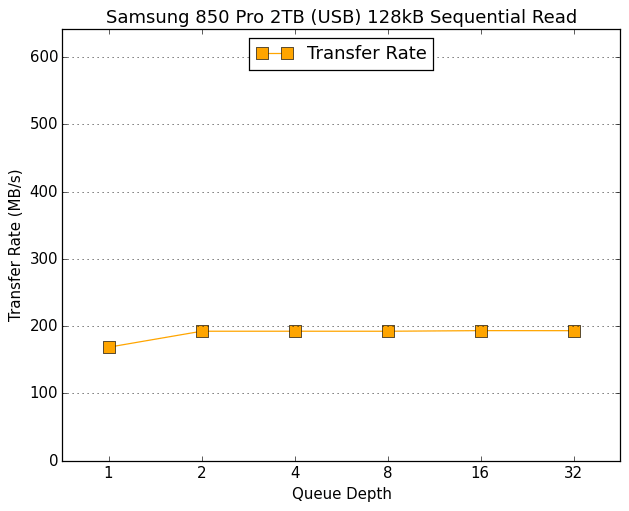 |
|||||||||
| Samsung 850 Pro 2TB (SATA) | Samsung 850 Pro 2TB (USB) | ||||||||
| Seagate Barracuda 3TB (SATA) | Seagate Barracuda 3TB (USB) | ||||||||
Both the SSD and hard drive show slightly lower QD1 performance in the dock than the very steady performance at all higher queue depths. This suggests there's a bit of command processing latency in the dock that can be masked by queuing up requests, but it's unclear why the SSDs sequential read performance ends up lower than the hard drive's.
Sequential Write Performance
The sequential write test follows the same timing and queue depth schedule as the sequential read test, and is scored the same.
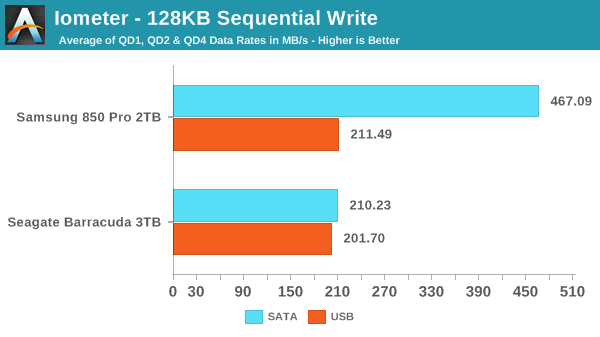
Sequential write performance is very similar to sequential read for the hard drive, with slight overhead due to the dock. The SSD manages to beat the hard drive when docked this time, but is still severely restricted by the slower interfaces.
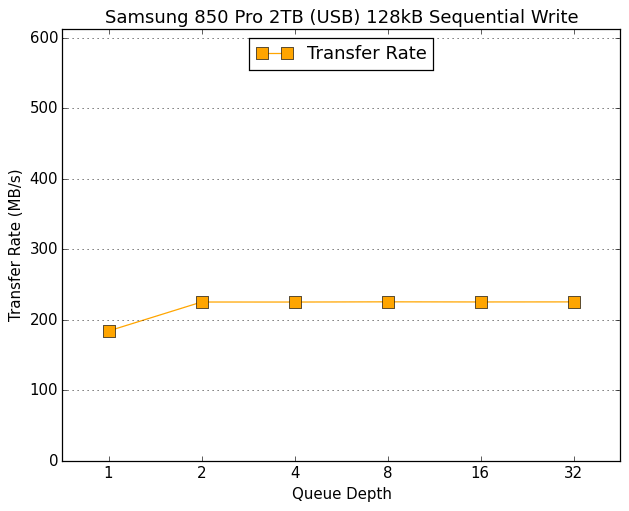 |
|||||||||
| Samsung 850 Pro 2TB (SATA) | Samsung 850 Pro 2TB (USB) | ||||||||
| Seagate Barracuda 3TB (SATA) | Seagate Barracuda 3TB (USB) | ||||||||
Again QD1 performance is slightly lower for both drives in the dock and the dock is only able to keep pace with the mechanical drive, but there are no other surprises from it on this test.
Mixed Sequential Read/Write Performance
The mixed sequential access test covers the entire span of the drive and uses a queue depth of one. It starts with a pure read test and gradually increases the proprotion of writes, finishing with pure writes. Each subtest lasts for 3 minutes, for a total test duration of 18 minutes.
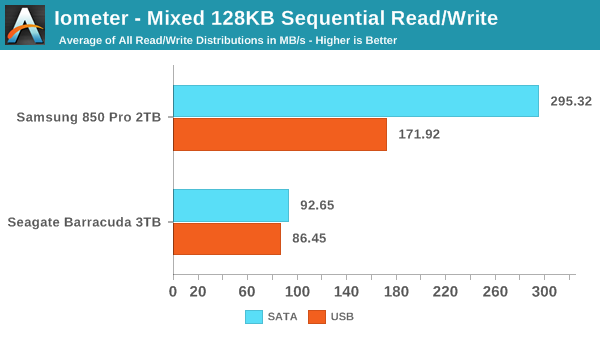
The mixed sequential test is the best showing from the dock. SSDs usually perform much worse on mixed sequential workloads than on pure read or write sequential access, so the dock's performance limits don't look as bad in this light. The hard drive's mixed sequential performance is also much worse than for pure reads or writes, and the dock's overhead is minor.
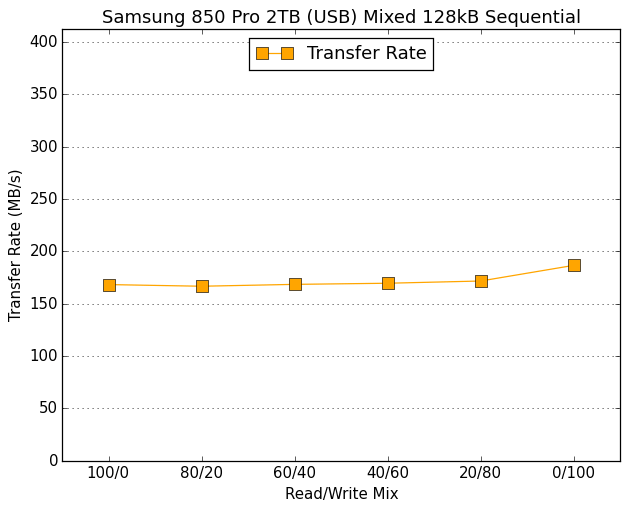 |
|||||||||
| Samsung 850 Pro 2TB (SATA) | Samsung 850 Pro 2TB (USB) | ||||||||
| Seagate Barracuda 3TB (SATA) | Seagate Barracuda 3TB (USB) | ||||||||
The dock limits the SSD to mostly-uniform performance across the mixed sequential test that is all well below what the drive can do with an internal 6Gbps SATA connection. For the hard drive, the only significant differences are moderate performance penalties on the pure-read and pure-write portions of the test.










38 Comments
View All Comments
Murloc - Tuesday, February 16, 2016 - link
I guess the point of this thing is being easy to use for employees, the time is not really a concern if you have other work to do anyway.The USB dock thing looks like something they just slapped there since people may want to check what's on a drive they found before wiping it. So performance is not really key.
edzieba - Tuesday, February 16, 2016 - link
The "erase by overwriting" method is completely redundant for any HDD implementing ATA SECURE ERASE. Not only is SE the fastest method to wipe data (limited only by the drive controller, not the interface) it wiped sectors in the G-list that a normal wipe would miss. This includes DBAN and other redundant multi-overwrite methods. Multiple overwrites have been entirely unnecessary since the invention of the GMR head well over two decades ago.Babar Javied - Tuesday, February 16, 2016 - link
Expand please?I have never even heard of ATA secure erase but it sounds interesting. How does this make overwriting redundant? since the data on the platters does need to be erased
joex4444 - Tuesday, February 16, 2016 - link
It's a little surprising you've never heard of it since it was mentioned in the 3rd paragraph of the article, albeit quickly.Guspaz - Tuesday, February 16, 2016 - link
This assumes that you trust the drive's secure erase implementation. Following up the secure erase with a single overwrite is probably sufficient.Azethoth - Wednesday, February 17, 2016 - link
Exactly. Secure erase on SSD just marks all blocks as empty, so factory default but the data is really still there. Absent proof of no physical way to access these blocks and read their data you really do need to overwrite at least once and take the hit to longevity ;-)azrael- - Thursday, February 18, 2016 - link
Apparently you didn't read the article either (or anywhere else it has been written). Securely erasing an SSD usually consists of the drive throwing away the encryption key it has used for storing your data. The data is still there, but noone can read them.Senti - Friday, February 19, 2016 - link
The keyword here is "usually". Imagine you are the one responsible for secure deletion of information: would you blindly believe that "drive should do it properly and not leave the old key somewhere" or would you double-check? The answer is obvious.Lerianis - Saturday, February 20, 2016 - link
Considering that this is being done by tech literate organizations. I think they would have verified the whole "No way to restore the drive!" that they are pushing.leexgx - Saturday, February 20, 2016 - link
i guess he should of not used the word "usually"if the drive uses AES encryption (SED drive) then all the drive has to do is reset the key when Secure erase is done (this is why it can take upto 1-2 hours to wipe none encryption HDD drive) and all data is lost and if that is not enough it also commands the Trim all parts of the flash so all NAND is clean all parts of the SSD will come back with 00000000 (unlike a HDD there is a chance to recover data but if its a self encryption HDD/SSD drive then there is no data recovery once ATA Secure erase has been used)
if ATA secure erase takes more than 2 minutes on a Self encrypting drive(HDD or SSD), the drive it self is not encrypted as SED drives should just reset the keys and all data has gone puff (full TRIM on all parts of the flash is also performed as well to bring the drive to a complete clean and max performance state)
on SSDs even none SED drives a secure erase should only take 30 seconds - 2 minutes as all it has to do is command reset the pages and TRIM the whole drive witch is a very fast task